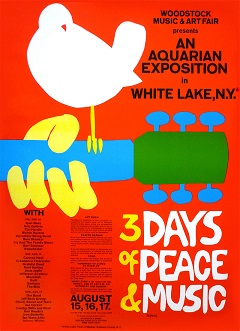Woodstock 1969

Woodstock 1969 Information
- Woodstock 1969 Lineup and Performers
- Woodstock 1969 Stories
- Woodstock 1969 Pictures and Photos
- Santana at Woodstock 69
- Jimi Hendrix at Woodstock 69
- Janis Joplin at Woodstock 1969
- Joe Cocker at Woodstock 1969
- Woodstock 1969 DVD video
- Woodstock 1969 Movie
- Woodstock 1969 Poster
- More Woodstock 1969 Information
The Woodstock Music and Art Fair - August 15-18 1969
Woodstock 1969: Overview and Cultural Influence
The events that led up to the legendary Woodstock 1969 festival were destined to happen. The organization overcame many barriers and many fateful occurrences lined up its fruition. Here is a brief overview of the legendary Woodstock 1969 festival and the impact it had on music, American culture, and the world.
Woodstock was the pop culture music event of the decade and arguably to this day the single most profound event in the history of music. Acts from all around the world met at Max Yasgur's Farm in Bethel, NY on August 15-18, 1969 for a celebration of peace and music. What began as a paid event drew so many viewers from across the world that the fences were torn down and it became a free concert open to the public. 500,000 youthful individuals gathered peacefully at Woodstock 1969 creating the largest gathering of human beings in one place in history. Woodstock 1969 defined an entire generation and its effects on music and American culture can still be felt today.
Woodstock '69 featured one of the most prolific musical lineups in history including such icons as Jimi Hendrix, Janis Joplin, Joe Cocker, Santana, and The Who. Fans got a taste of a variety of music styles which came together in perfect harmony. The crowd at Woodstock in 1969, which reached near a half a million people sent a message to the world that individuals could come together peacefully to celebrate peace and music.
Such an extravagant event warranted the production of an academy award winning documentary of Woodstock 1969 and a number of popular Woodstock film and album releases. The Woodstock 1969 poster has come to be one of the most famous images in American culture as well as a symbol of peace. Hollywood movies are still being made to celebrate the event such as Taking Woodstock, the story of Elliot Tiber.
The music at Woodstock in 1969 embodied extraordinary popular acts from all over the world. Legendary performances by such music icons as Jimi Hendrix, Joan Baez, Joe Cocker, Santana, the Grateful Dead and Janis Joplin are still considered landmarks in music history. Woodstock in 1969 was also among the last performances of Jimi Hendrix and Janis Joplin who are seen as some of the best in their respective fields. The entire psychedelic music vein became popularized at Woodstock 69 and still influences bands of all ages to this day.
Hippie is a term that has not diminished in popularity or as a subculture to this day. The youth of the 1960's all came together with similar ideals and became the most popular counterculture archetype. The hippie culture shook the foundation of conformity to its core, reports of attempts to disperse the half a million individuals have been surfacing ever since the event. Individuals able to organize in that magnitude for a common interest was something that those in power were absolutely terrified of and had every right to be. Had Woodstock 1969's focus turned from music to revolution, the world would be an entirely different place today.
After Woodstock 1969, the name "Woodstock" became a very profitable brand name. The concert was initially designed as a money making endeavor. Woodstock Ventures ended up going far into the basement monetarily after the concert, but eventually recovered and became the corporate enterprise that it is known as today. The recent installments have been seen as corporatized disasters; however, the impact of the initial event is still so profound to this day that anything with the Woodstock brand tacked onto it draws a large amount of attention. Woodstock 1969 has since been a household name and integrated into mainstream American living.



